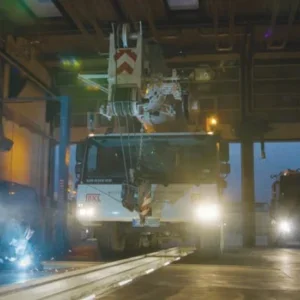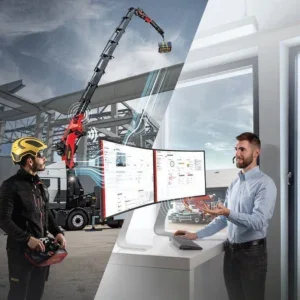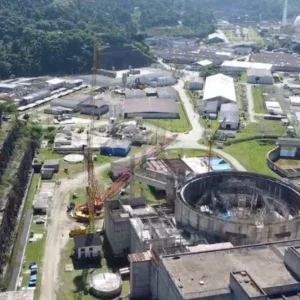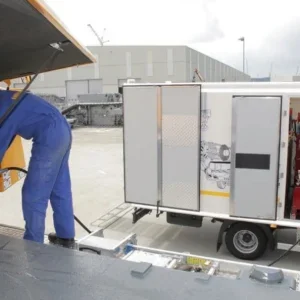The earthquake that hit the Italian city of L’Aquila on 6 April killed some 300 people and left 65,000 homeless. It also destroyed many of the town’s 13th century buildings, heritage sites and churches. Some 1,360 buildings are being reconstructed and 4,500 new homes being built.
Today, the view of the city’s skyline is not one of mediaeval cupolas and domes but of cranes and scaffolding. In the immediate aftermath of the quake, cranes were used to help locate survivors and bodies, make buildings safe and recover valuable artworks, including an altarpiece and even the relics of a 15th century saint. In the National Museum of Abruzzo, cranes able to lift 100t were used to install heavy steel beams and to remove unsafe sections of a reinforced concrete roof.
All this work was hampered, however, not just by dangerous structures and rubble but also by the confined spaces the cranes had to fit into. It’s a common problem in many medieval Italian cities, where the streets are so narrow you can stretch out your arms and touch the walls on opposite sides of the street at the same time. Such conditions make life very difficult and frustrating for construction workers and crane operators. But the Italian crane industry is addressing the issue in some ingenious ways.
At SAIE last year, Fassi introduced its compact new knuckleboom crane, the F30CY, powered by a battery and specifically designed to work in small city streets. It comes in three sizes: the F30CY.21, which has a 4.15m reach and weighs 390kg; the F30CY.22, with a 5.30m reach and weighing 425kg; and the F30CY.23 CITY, which has a 6.45m reach and weighs 450kg.
Locatelli offers two models of city crane specially designed to operate in congested cities and suitable for use on construction sites where space is tight. The ATC 20 and ATC 40, respectively offering lifting capacities of 20t and 40t, combine high-profile crane technology with compactness, manoeuvrability, the pick-and-carry capacity of RT cranes and the comfort and high speed of a motor vehicle. Each has four-wheel drive and steering, adjustable hydro-gas suspension, no front outreach during the march on the road and 360° unrestricted visibility when lifting.
“Both the ATC 20 and the ATC 40 are small in size, big in performance and can be driven very fast on the road [at more than 70km/h] so they are ideal for rental companies, construction companies and public works,” says Massimo Casotto, sales manager for Locatelli. “We are working on further improvements on these models, particularly for the ATC 40 city crane, to meet customers’ specific needs.”
At SAIE 2008,Terex showcased two of its self-erecting cranes, the CBR 30 Plus and the FC 6.24 H, both of which perform well in narrow and confined spaces as they feature simple handling and short rigging times. In bothmodels, assembly is fully hydraulic andmodern drive technology ensures efficient operation.
The Terex CBR 30 Plus, with a maximum reach of 30m and a hook height of 21.7m, has a lifting capacity of 1t. With its compact dimensions, it can be transported on the road by a standard truck without needing to disassemble the individual components, enabling it to be moved quickly and flexibly between building sites. The Terex FC 6.24 H has minimal space requirements for the carrier base of only 2.5m x 2.5m, which can be reduced to 1.3m x 1.3m, making it ideal for building sites with difficult access or renovation work in town centres with narrow, twisting streets. As well as small dimensions, it features simplicity of transport, varied uses and a patented system that enables it to be erected without any additional aids. Since it can be completely disassembled, and its longest component is only 3.1m long, transport and storage are particularly space saving.
Another Terex crane well equipped for small spaces is the AC 30 City, which can be used inside buildings and on difficult terrain and includes versatile attachments to ensure universal applicability. It has a maximum lifting capacity/radius of 30t/2.7m, a main boom of 5-25m, an overall length of 8.4m and a short carrier length of 6.88m. Its slightly bigger brother, the AC 40 City, is the most compact three-axle crane in its category, says Terex, and is extremely manoeuvrable off-road, with a runner for in-door applications. It has a maximum lifting capacity/radius of 40t/3m, a main boom of 7.8–31.2m, an overall length of 8.57m and a short carrier length of 7.09m.
Both City cranes are fast on the road, with a maximum travel speed of 85km/h, and have a low clearance height of three metres.
Another solution gaining popularity is the portal, which raises the crane above the ground, leaving the street below free for easy access. On example of this is GelCo’s self-erecting tower crane mounted on a pedestal, which can occupy the full width of a narrow street but enables pedestrians and vehicles to simply pass through the gap beneath its chassis and four hydraulically jacked legs. The ‘Clever Crane’ range has three key patented features, explains Cristian Torri, export manager of GelCo’s distributor Compass Consulting, which debuted the range at SAIE in 2006. “The most noticeable difference between GelCo’s cranes and other self-erectors is the set of four legs that can lift the entire unit 2.75m into the air,” he says. “Each leg is extended with a separate, independent hydraulic jack, enabling the crane to be safely erected on a slope or with two of the legs standing on a ledge, higher than the others. The extra height the legs give to the chassis can make it easier to extend the crane’s jib in tight spaces.”
The crane is designed to be steered under its own power through narrow, winding and sloping roads at gradients of up to 25°. A four-stroke motor on the chassis provides power to four wheels that are steered and controlled through an electronic console at the rear of the crane. Another patented feature is its compactness. A third section to the crane’s telescopic mast both increases its height in use and reduces its folded length when being transported. The largest crane in the range, the 31.7m-tall G 2626 TTBE, can be folded and transported in a unit only 9.9m-long. This model can lift 700kg at 25.5m, or 1,500kg at 12.5m.
Liebherr has designed its Universal Portal for use on narrow city centre construction sites and on those situated on busy roads that can’t be closed during works. The special feature of this new portal design is the integral standard cruciform base. By adding side frames, even large, heavy vehicles such as trucks and buses can pass through the portal, which can support top-slewing cranes up to 154t and bottom-slewing cranes up to 71t. As a technical refinement, the integral support base can serve as a standard cruciform base, an additional operating feature that can lead to considerable cost savings and help to optimise the crane fleet. The crane can operate in the same way as one on a standard cruciform base, either stationary on spindles with pyramidal supports or foundation blocks, or as a mobile version with suitable travel gear.
The portal is easy to assemble, the main parts of the cruciform base and the portal supports being assembled on the ground to form two separate frames, which are then raised and bolted together. For safe erecting, ladders and erecting platforms are available which also allow access to the crane itself. Universal connectors for 120 HC and 140 HC tower systems are pre-installed. Adapters for bolting on fast-erecting cranes from the K and TT series are available. The portal support width is 4.6m x 4.6m, vehicle headroom is 4.3m and the available width of the roadway 4m. Overall dimensions are 5.3m x 5.3m.
FB Gru has also developed a similar portal on a cruciform base, which is capable of supporting all FB Gru’s cranes, especially the new GHS family of cranes that have been designed to be erected easily, all with elements 6m-long to make transport with light vehicles easier.
Perhaps the biggest challenge to working in narrow mediaeval streets comes in negotiating a tight corner. Gruppo Gavarini has developed a versatile remote-controlled dolly called the GAPO 16, which can not only move sideways and, with 180 degree steering, turn in its own width but takes steps in its stride. There are two models, the DA 10 and DA 16, with pulling power of 10kN and 16kN, which Gavarini said is powerful enough to tow any self-erecting tower crane, though the DA16 is expected to be the bigger seller.
Designed for moving self-erecting tower cranes and industrial machines on site, the self-steering one-axle machine has two large drive wheels with two very small, castor-type wheels for balance, allowing it to move a crane over rough terrain at up to 5km/h and on slopes of up to 30°. It can be either remotely or manually operated and, when used manually, requires only one operator. It can pull or push up to 25t and lift up to 11t. Measuring 2,030mm x 1,570mm and 965mm high, with the hitch in its lowest position, the hydrostatic drive GAPO is powered by a three-cylinder 28kWYanmar diesel engine and weighs less than 2t. The GAPO also supplies a remote-controlled, hydraulically powered two-wheeled steering axle that can be used to support the other end of the crane so that it can be moved sideways.
Gavarini designed the GAPO in conjunction with Potain, for which it is the dealer in Italy (the name GAPO is taken from the first two letters of each company’s name), though the unit can be fitted with different hitch plates to work with any make of crane or trailer. As the Potain dealer for Italy, which has been supplying cranes and construction equipment for more than 50 years, Gavarini has a sizeable self-erector fleet. The company first conceived the idea for a mechanised dolly about 15 years ago and built the first prototype some eight years ago, before debuting it at SAIE in 2008, where it received a lot of attention from at least three UK crane companies, one of which – Ladybird Crane Hire – placed an order. Ladybird trialled it in the challenging location of Mevagissey, Cornwall, by using the GAPO to install a Potain Igo 21 self-erecting tower crane, which it then manoeuvred around three tight corners and drove along the edge of the harbour and through the difficult access gates of the building site.
In Italy, the GAPO is proving popular with hirers and haulage contractors to install, load and unload self-erecting cranes for a variety of applications. Marco Gavarini, head of the company, says the GA 16 is especially well suited to rental firms and companies in the logistics sector and transport companies wishing to move semi-trailers on their own site. GB Manci Noleggi is a major hirer in northern Italy that works in the ski resorts of the Dolomites and has used the GAPO to solve many crane installation problems. The mountainous terrain of the area means that most houses are built in places difficult to reach by truck or telehandler but, using the GAPO, the company has managed to position self-erecting cranes jibs up to 40m. “This powerful machine makes the difference between being able to do the job or not, as it makes it possible to reach previously inaccessible locations,” says managing director Andrea Manci. “It’s the difference between getting a crane on site – and a hire – or not.”
In the past, cranes were moved and positioned by using inadequate machinery such as excavators and wheeled loaders which, as they are not designed for that purpose, can be hazardous for the operator. As the GAPO is fully remote-controlled and can be used by just one operator, the customer can save on labour and the operator can work from a safe distance and with a wide view of the crane. These reasons are why one of the largest Liebherr hirers in northern Italy, Niederstätter, decided to use the GAPO as its new self-erecting cranes transport system, according to general manager Antonio Niederstätter “The GAPO is really able to improve speed and efficiency on site,”he says “We’re very satisfied with its performance.”
Aristei Aototrasporti, a large crane haulage contractor in central Italy, is working in Abruzzo, the region struck by the April earthquake, where it is using the GAPO in rebuilding houses, government offices, and ancient and historical buildings. Aristei says, “Here the GAPO is really useful in moving cranes quickly from one building site to another in an area where there are hundreds of sites crammed together in close proximity, and almost every building needs to be restored or rebuilt.”






